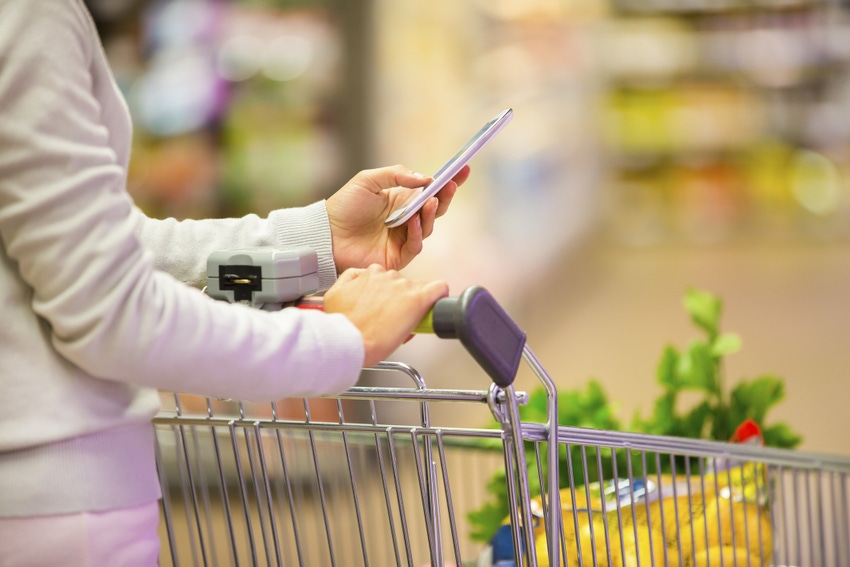
The future of grocery shopping has been debated for decades because it’s been changing for decades, but the speed of change—driven by everything from smartphones to data analytics—has turned up the volume on that debate. Nutrition Business Journal invited two experts with very different views on retail trends to share their opinions. Their ideas are reflected in the Nutrition Business Journal Sales Channel Report, available now.
Omnishopping: Grocery’s new normal
 By Linda Shein, LBShein & Company
By Linda Shein, LBShein & Company
Arguments abound that online grocery is over-hyped and especially that the desire for “fresh” will continue to drive consumers to physical stores to touch, feel and select their food, versus other sectors that are more vulnerable. But these arguments miss the point: To compete in the Amazon era, successful retailers across all segments must offer a seamless customer experience across online and offline touchpoints, leveraging physical stores to create new, more sensory, engaging and differentiated experiences.
Retail is now channel agnostic—customers shop 24/7 from anywhere, checking their phones over 200 times a day, and the journey for a single sale crosses multiple channels and devices. Even the term “omnichannel” is obsolete, as this is our new normal retail. Online versus offline is siloed thinking that must yield to seeing through the eyes of the consumer, meeting her wherever she is, whenever she shops—in a store, at a red light, while in a meeting or even from the bathroom.
Still, while online grocery in the U.S. has lagged other sectors in reaching the “tipping point” we have seen in books, fashion, sporting goods, toys, etc., grocery is in the early stages of digital disruption with massive changes on the horizon. It is interesting to consider that the center of the store is most vulnerable, given branded packaged goods are ubiquitously available and price comparison engines drive consumers to the lowest price offered, such that private label and fresh are the future to a differentiated product offering. Regardless, the Food Marketing Institute and Nielson together predict that 70 percent of consumers will buy at least some groceries online in the next five to seven years, and unlike at any time in the past, new shopping patterns are now driven largely by technology, which continues to change at an ever-increasing rate (i.e., this is not slowing down, and agility will be the key to success). It is hard to imagine the iPhone was introduced only 10 years ago, with consumers now on mobile devices hundreds of times a day including time spent in “pre-commerce” discovery—even if, for now, most conversion still happens on a larger screen or in physical stores.
Rather than looking inside the U.S., where retailers have not cracked the online grocery code, let’s look to the U.K. to learn from a model of success. Ocado is a U.K. online-only grocer that dispels many myths around online grocery. (I recently had the privilege of hearing the CEO speak alongside the CEOs of Target and Shipt discussing their new relationship, Walmart e-commerce which is rolling out home delivery to another 1000 stores, and Sprouts and AmazonGo leadership as well). At $2 billion a year and profitable, Ocado is now investing in doubling capacity; its largest warehouse ships 2 million items a day, with more fresh and organic offerings than the largest U.K. brick-and-mortar grocers. It guarantees lower prices than the least expensive offline grocer, as well as one-hour delivery to anywhere. Most interestingly, shoppers cut across all age groups and are not dominated by millennials. While the U.K. is not the U.S., it is interesting to observe as we pursue the optimization of U.S. grocery offerings across channels.
In many ways, everything has changed in retail, but in the most important way nothing has changed: The customer is still queen (or king), and we still must meet her wherever, whenever with whatever she demands, across all channels and devices. Today, however, offering the right product at the right time in the right quantity at the right price are simply table stakes and are no longer differentiators. Today’s consumers no longer buy stuff. Instead they seek experiences. They are accustomed to more engaging and personalized experiences online, where data mining enables a highly individualized path to purchase—including presenting products and experiences curated based on prior shopping patterns that can be merged with physical store history enabling one view of each customer. Retail winners will be those who adapt readily to constant change and keep their eye on the ball to continuously reinvent the customer experience, whether online or offline, which is what successful retailers have always known.
Linda Shein is a retail and e-commerce consultant helping retailers transform and brands scale in the digital era. She was previously managing director of The Wharton School’s Retail Innovation Think Tank and has served on natural products company boards.
A slap in the face for Amazon?
 By Alan Lewis, Natural Grocers
By Alan Lewis, Natural Grocers
Retail hasn’t changed much over the last 100 years. Even without AI drones and the internet, the Great Atlantic and Pacific (A&P) grocery chain offered one-hour home delivery of fresh groceries and pantry staples—on credit—from dozens of distribution centers and 16,000 storefronts back in the 1930s. The A&P’s global supply chain and inbound logistics set the standard for food safety, standardization, private label products, freshness, affordability and convenience.
A&P’s control over the grocery business was so successful that some states outlawed its chain stores, and Congress investigated its monopolistic practices. When A&P disintegrated after the death of its founders, Sam Walton adopted its methods and augmented them with modern communication tools to expand his empire of mega stores. Untold numbers of small wholesalers and their independent storefronts folded, unable to complete on price, selection and overhead.
In the 1990s, with the advent of broadband internet, Jeff Bezos posed the question, Why build retail stores at all? He founded Amazon on the premise that shoppers didn’t value place, experience, brands or community as much as they valued lower prices, unlimited selection and the convenience of home delivery. Low prices worked their magic for a while, but it became apparent that human nature would not always bend to accommodate Bezos’s business model. Maybe place and community mattered. Amazon created a slew of fake “authentic” brands, mimicked community through product reviews, and tried to make Amazon.com itself a virtual place to gather, share and learn.
You can buy everything you need through Amazon if you want to. But you don’t. Why is that?
The reason is simple: The grocery business is adapting faster than Amazon can keep up. Business analytics firm CB Insights has identified a bevy of innovations given flight by brick-and-mortar retailers: one-hour delivery through partners and in-house services; seamless integration of online browsing with in-store shopping, order pickup and home delivery; high quality private brands with back stories and strong margins; partnerships with established online brands to capture their expertise, brand cache and customer base; highly targeted digital promotions; robust customer analytics; streamlined global supply chains; real-time optimized pricing; cashier-less shopping and more. The tech startup community is awash with new systems and apps to support these competitive tactics.
The American grocery store has one job and does it well: We put food, sundries and dietary supplements on shelves within a mile of your home. We sell small packages that fit your kitchen, fresh food that lasts a week, and thousands of specialty items that make every meal and nutrition plan unique to you and your family. And we do all this at a weekly cost in step with the cadence of your paychecks.
Human shoppers stubbornly continue to find affinity with what they can see, touch, smell and experience. Online retailers, forced to concede that innate human behavior is a real thing, now open brick-and-mortar stores to better connect with customers. As the leader of Amazon, Jeff Bezos, acts like a teenager with no real-world romantic experience: He imagines his love interest will only behave in ways that please and comfort him. His idealized human shopper is supposed to adapt compliantly to all of Amazon’s needs and limitations. Get ready for a slap in the face, Amazon.
Amazon’s tests of its Go store effectively delivers on its beige-brand promise. Go offers anonymous purchases of generic products with no human interaction and unconditional surrender of personal and financial privacy. Go’s meager plans to open only six new pilot stores confirms even Amazon’s slim confidence in the model. The VPs in charge of Go recently admitted with amazement that the store requires changing behaviors that consumers have had their whole lives.
Amazon’s biggest strength is its freedom from financial constraints. Awash with investor funding and cashflow from its web services division, it can sell and deliver products at a loss while attempting to dominate the market for food and dietary supplements. Its weakness remains logistics. Despite its hallowed success with tech-savvy sourcing, warehousing and delivery, it is unlikely it can build a durable cold-chain model given the cost of the last mile—the same last mile where conventional grocery stores are smartest, and getting smarter. The bizarre acquisition of Whole Foods, a company known for its convoluted supply chain, hardly brings insight and savvy to Amazon’s ranks. But online buyers most often buy online from the same grocery store they frequent. Amazon needed brick-and-mortar customers to convert to online grocery ordering.
Putting aside the fantasy of buzzing ninja drones dropping frozen ice cream and raw chicken on your front porch on a summer day, it takes thousands of individual Amazon truck deliveries to resell the contents of a single incoming semi-trailer load of goods. That’s why we see rented U-Haul vans driven by gig workers careening through our neighborhoods dropping off boxes at all hours. But for every new distribution node that Amazon builds, the grocery business already operates hundreds of its own. The A&P model never died; it just morphed into today’s neighborhood supermarkets, supported by modern global supply chains.
Amazon’s logistical problems are amplified in rural areas: If you’re concerned about the vitality of our rural communities, don’t count on Jeff Bezos to support them. Amazon’s model works best in high-density areas, where it can take advantage of tax incentives, existing transportation and communications infrastructure, underemployed workers, and public assistance for underpaid and part-time labor. In 2016, The Institute for Local Self-Reliance issued a scathing 79-page report on the “Amazon Stranglehold” which details the company’s abdication of responsibility to our communities while it demands privileged tax treatment and free infrastructure upgrades. Ultimately, predatory companies are called to account.
After hundreds of first-person interviews with household food buyers, consumer research firm GutCheck recently found the most common reasons cited for shopping on Amazon.com are lower prices and saving time. But it noted the biggest barriers are ordering/delivery costs and the suspect quality of fresh food. People like to choose their own. If Amazon can afford to subsidize Amazon’s prices and delivery costs, it may grow market share. But if America’s grocery stores do what they do best—provide a wide selection of affordable quality products near our homes—Amazon must continue to invest in its desperately underpriced home delivery business model.
Which brings us back to the right questions. Why don’t we buy everything from Amazon? Why do millions of us flock to grocery stores every day? Why are offline dietary supplement sales still strong? Well, because the neighborhood grocery store is where we see our neighbors, get answers from experts, taste new foods, and find new products that surprise and delight us. We even stop at several stores each week because, it seems, we can’t get enough. Each is a place with people, products and relationships that are meaningful. Jeff Bezos’s gift to the grocery and dietary supplement industry is reminding us of what we knew really mattered all along. The single most important initiative in retail is the customer experience. Try as it may (and they try really, really hard), Amazon just can’t measure up.
Alan Lewis navigates food and agriculture policy and government affairs for Natural Grocers, a chain of 144 health food stores in 19 states.
 There's more where that came from. With 165 pages of detailed data that tell the story of where different product categories are selling, plus insight that will bring executives up to speed on ever-evolving dynamics, the Sales Channel Report is a tool to keep an omnichannel strategy running with optimal returns. Learn more.
There's more where that came from. With 165 pages of detailed data that tell the story of where different product categories are selling, plus insight that will bring executives up to speed on ever-evolving dynamics, the Sales Channel Report is a tool to keep an omnichannel strategy running with optimal returns. Learn more.
About the Author(s)
You May Also Like







